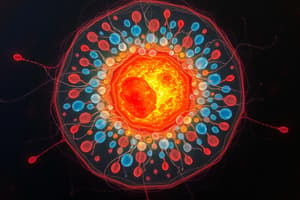Podcast
Questions and Answers
What is the composition by dry weight of the nucleus?
What is the composition by dry weight of the nucleus?
What is the main site for enzyme activity in the nucleus?
What is the main site for enzyme activity in the nucleus?
What are chromosomes made of?
What are chromosomes made of?
How many chromosomes do humans have?
How many chromosomes do humans have?
Signup and view all the answers
What is the term for the two chromosomes in a homologous pair that carry the same type of genetic information?
What is the term for the two chromosomes in a homologous pair that carry the same type of genetic information?
Signup and view all the answers
Which chromosomes determine a person's biological sex?
Which chromosomes determine a person's biological sex?
Signup and view all the answers
What are telomeres?
What are telomeres?
Signup and view all the answers
What is karyotyping used for?
What is karyotyping used for?
Signup and view all the answers
What is found at the ends of each chromosome to protect them?
What is found at the ends of each chromosome to protect them?
Signup and view all the answers
What is the name for the localized region of the chromosome with which spindle fibers attach?
What is the name for the localized region of the chromosome with which spindle fibers attach?
Signup and view all the answers
Which structure in the nucleus is related to the production of ribosomal RNA molecules and assembly of ribosomes?
Which structure in the nucleus is related to the production of ribosomal RNA molecules and assembly of ribosomes?
Signup and view all the answers
What makes up approximately 80% of the total chromosomal protein?
What makes up approximately 80% of the total chromosomal protein?
Signup and view all the answers
What is the primary function of the nucleus in a eukaryotic cell?
What is the primary function of the nucleus in a eukaryotic cell?
Signup and view all the answers
Which organelle is known as the administrative center of the cell?
Which organelle is known as the administrative center of the cell?
Signup and view all the answers
In which type of cells is it common to find no nucleus?
In which type of cells is it common to find no nucleus?
Signup and view all the answers
What percentage of the total cell volume does the average nucleus occupy in mammalian cells?
What percentage of the total cell volume does the average nucleus occupy in mammalian cells?
Signup and view all the answers
Which type of cells are classified as polynucleated?
Which type of cells are classified as polynucleated?
Signup and view all the answers
What determines the shape of the nucleus in a cell?
What determines the shape of the nucleus in a cell?
Signup and view all the answers
Which organelle has the largest cellular organelle in animal cells?
Which organelle has the largest cellular organelle in animal cells?
Signup and view all the answers
In which type of cells is it common to find more than one nucleus?
In which type of cells is it common to find more than one nucleus?
Signup and view all the answers
What is the average diameter of the nucleus in mammalian cells?
What is the average diameter of the nucleus in mammalian cells?
Signup and view all the answers
Which type of cells are classified as mononucleate?
Which type of cells are classified as mononucleate?
Signup and view all the answers
Study Notes
- The nucleus is a membrane-enclosed organelle found in eukaryotic cells, serving as the information processing and administrative center.
- The nucleus is the largest cellular organelle, storing the cell's hereditary material (DNA) and coordinating cell activities.
- Cells contain one to multiple nuclei, depending on the type, and their shape and size can vary.
- The nucleus is surrounded by a nuclear envelope with inner and outer membranes, with nuclear pores controlling the movement of molecules.
- The nucleoplasm is a fluid substance within the nucleus, mainly composed of proteinaceous materials and enzymes, separated from the cytoplasm by the nuclear envelope.
- The nucleolus is a densely stained structure inside the nucleus, responsible for producing ribosomal RNA molecules and assembling ribosomes.
- Chromosomes are thread-like structures inside the nucleus, made of protein and DNA, with histones and non-histone proteins that determine gene activity.
- Humans have 46 chromosomes, including 22 autosomes and 2 sex chromosomes (X and Y), determining biological sex (XX for females and XY for males).
- Chromosomes consist of identical sister chromatids attached by the centromere, which divides chromosomes into short and long arms.
- Chromosomes have telomeres at their ends, made up of repeated DNA sequences and protective proteins, preventing chromosome shortening during replication.
- Techniques such as karyotyping are used to study human chromosomes and determine the chromosome complement of an individual.
Studying That Suits You
Use AI to generate personalized quizzes and flashcards to suit your learning preferences.
Related Documents
Description
Telegram channel : https://t.me/mcqb2




